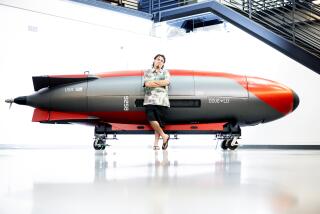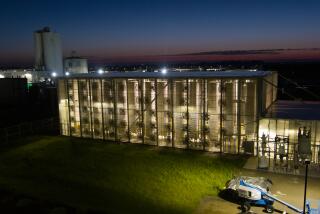Azusa Firm Packs High-Tech Design in Artillery Shells
- Share via
Cannons were first used by Christian armies in the Sixth Crusade in 1228, and over the next seven centuries, the basic concept of hurling a projectile at an enemy has remained pretty much the same.
But now, scientists and engineers at Aerojet ElectroSystems in Azusa are applying exotic space technology to build a better artillery system. The company was recently awarded a full-scale development contract by the Army.
If the effort is successful, a combination of advanced microcomputers, millimeter wave radar and infrared sensors will be packaged inside an artillery shell, which traditionally has been thought of as a relatively simple weapon. The SADARM would use the sophisticated electronics to fire high-speed projectiles, carried within the artillery shell, at armored vehicles.
For the Aerojet-General unit, the excursion into the world of artillery is something of a departure from its work in advanced space electronics, which has formed the core of its business over the last several decades.
Aerojet ElectroSystems builds the orbiting Defense Support Program sensor systems that keep 24-hour watch for a nuclear missile attack on the United States. The sensors aboard the DSP spacecraft can detect the plume of a missile within moments of launch and alert U.S. forces immediately.
Closely Held Secret
Although the DSP and related space work have made Aerojet ElectroSystems a leader in infrared and related electromagnetic technologies, the work is held so secret that the division is virtually unknown outside the industry.
Aerojet-General, which consists of five companies located in California and is ranked as the state’s ninth-largest defense contractor, is a subsidiary of GenCorp, a conglomerate involved in enterprises including tire manufacturing and broadcasting. Aerojet is best known for its work in rocket propulsion.
The ElectroSystems unit has sales of about $200 million annually and a work force of 2,100 at its 48-acre Azusa complex.
The new SADARM program brings certain risks to the company, since its forte has been the design and production of very small numbers of highly advanced space hardware.
To avoid becoming another Pentagon horror story involving a mismanaged weapons system, the SADARM must be produced at very low cost. The Army has set a price goal of $3,000 for each SADARM.
“It has no guidance system, which is the most expensive part of most other munitions systems,” said Terry O’Brien, ElectroSystems program manager for SADARM. “It has no moving parts and it requires no maintenance.”
The payoff to Aerojet could be substantial. The Army plans to buy as many as a half-million units, though the number may grow or shrink as the Army’s planning changes. The program will probably reach $1 billion in value.
Aerojet undoubtedly will not get all of that, because there will be other contractors competing for development and production awards.
The Army Armaments, Research and Development Command in Dover, N.J., awarded Aerojet an $87.2-million contract last month to begin full-scale development of SADARM. A $95-million contract was awarded to Minneapolis-based Honeywell, which is expected to compete with Aerojet for eventual production awards.
“We will get one-half of the market. Hopefully, that’s conservative,” said Sheldon Jones, president of ElectroSystems. “It is a big program for us. There’s no question about it.”
Honeywell, the Army’s leading munitions manufacturer, claims to have become the first contractor to successfully demonstrate full function of the SADARM system last year. But Aerojet does not consider Honeywell ahead in the competition.
“The system has been demonstrated in many forms,” O’Brien said. “Honeywell demonstrated some of those first, and Aerojet demonstrated others first.”
Just to participate in the competition, Jones figures that ElectroSystems will have to invest about $75 million for product development and production facilities. The company will start construction this month of a new engineering and office building. At peak production, the program would involve 600 workers, a number limited by the substantial amount of automation that will be necessary to hold down costs, Jones said.
The SADARM program could take ElectroSystems into the world of high-volume production. At the peak of production, a SADARM will come off the assembly line every two minutes.
Each eight-inch artillery shell will contain three SADARMs, and each 155-millimeter howitzer shell will contain two. A rocket-launched version will hold six.
The shells are to be fired from artillery guns toward tanks and other armored vehicles anywhere from roughly 10 to 15 miles away. At a pre-selected distance and altitude, the weapons are released from the artillery shell.
A special parachute opens, and the SADARM descends in a spiral pattern, enabling its sensors to begin sweeping the area for a target. A tiny infrared telescope pops out of the SADARM and searches for heat sources, such as from a vehicle engine. In addition, a radar that operates in the millimeter frequency of the light spectrum searches the area for reflected solar energy and also sends out active radar pulses and listens for an echo. Information from all three sensor systems is fed into a tiny computer that is mounted on two small circuit cards.
When the SADARM spots a target, it fires a very high velocity, self-forging projectile. Specifically, a six- to 10-pound load of high explosive LX-14 is set off behind a copper plate that looks like a small coffee cup saucer, O’Brien said.
The copper immediately forms into a six-inch-long rod that travels at 8,000 to 9,000 feet a second--about 6,000 miles an hour. It is designed to hit the top of the target vehicle, where armor plating is usually thinnest, and blast a hole. Fragmention and heat from the projectile literally blast the interior of the vehicle.
“This is smarter than a bullet, and it costs a lot less than a missile,” Jones said. “When this rod hits the tank, it not only punches a hole in the top, it sets fires, cuts cables, kills people.”
More to Read
Inside the business of entertainment
The Wide Shot brings you news, analysis and insights on everything from streaming wars to production — and what it all means for the future.
You may occasionally receive promotional content from the Los Angeles Times.











